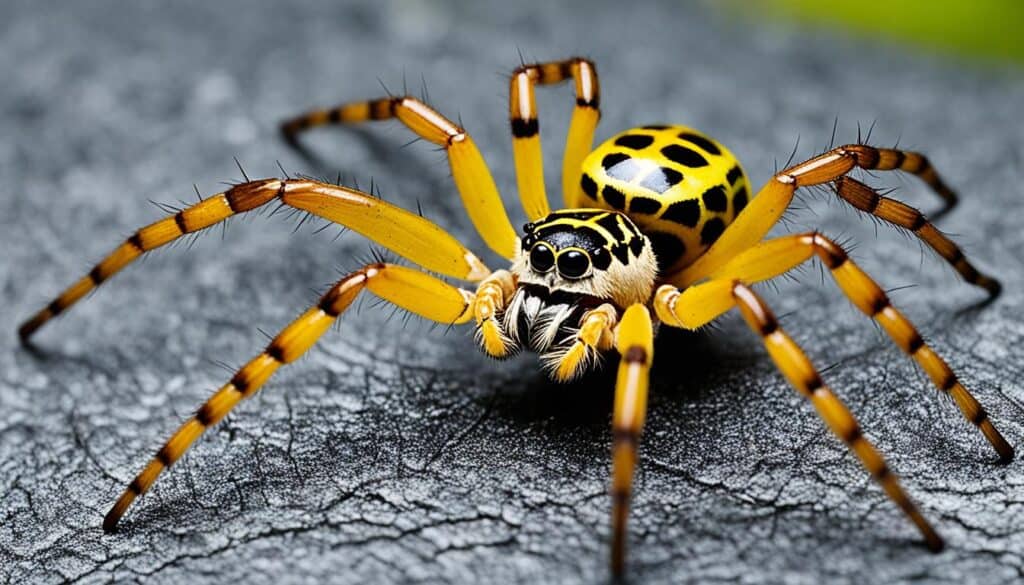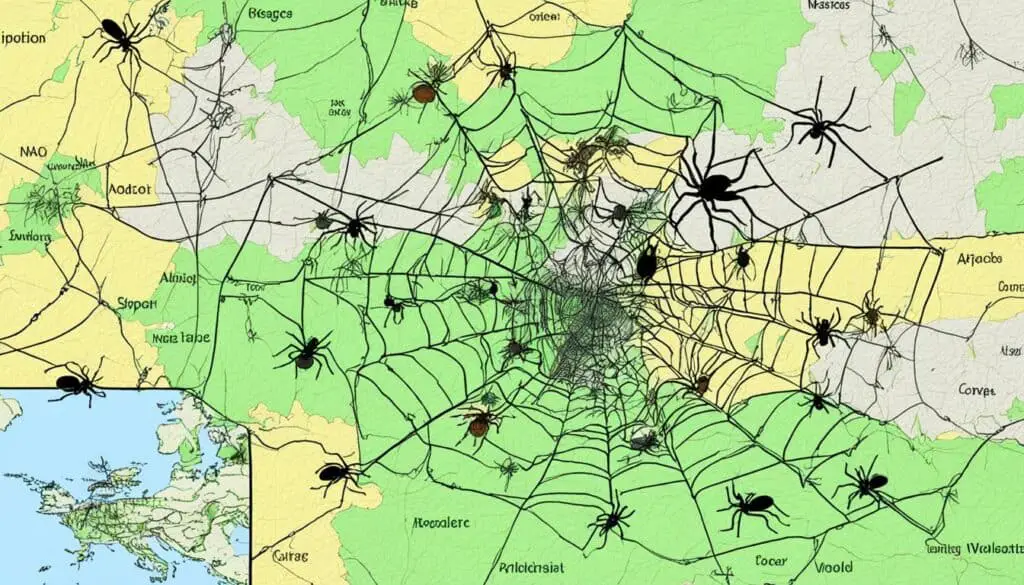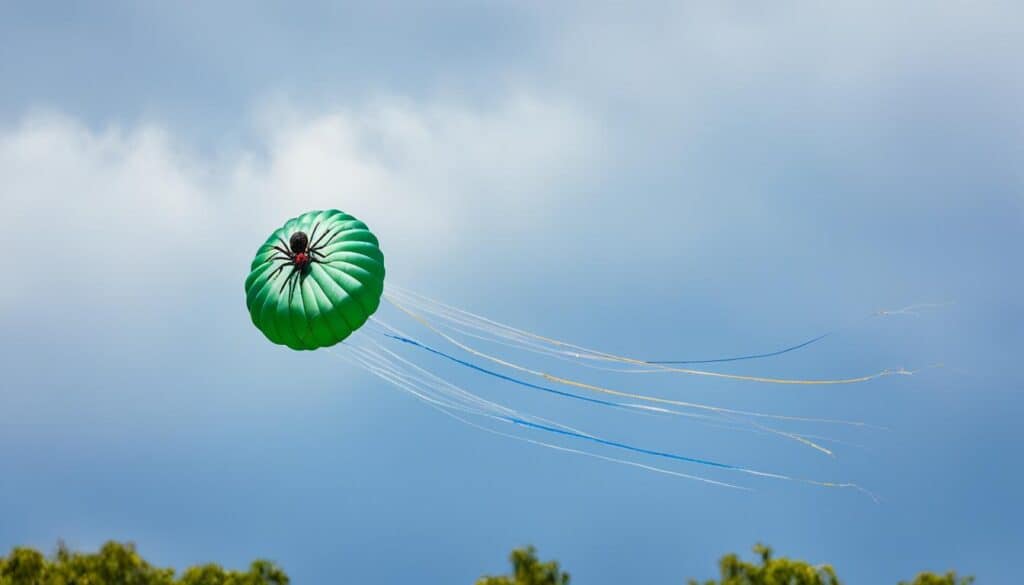Did you know about 1.2 billion people worldwide are scared of spiders? That’s close to 15% of everyone! Imagine this: the Joro spider can stretch its legs up to four inches wide. It has yellow and black marks, and it came to the southeastern United States from Japan in 2013. These spiders have been seen mostly in Georgia and nearby states. Experts think they could move to the northeast, like Ohio, very soon. That’s a journey you didn’t plan on taking.
These Joro spiders might seem like they’re out of a sci-fi movie, but they’re real. And they’re here to stay. Even though they have venom, their bites generally aren’t harmful. It feels like a tiny creature is biting you. If you disturb one, it might freeze and not move for over an hour. Controlling Joro spiders and reporting them is getting more important. They’re moving up and down the East Coast. So, are you ready to report your Joro spider sightings?
Key Takeaways
- Joro spiders arrived in the southeastern U.S. in 2013 and are rapidly spreading.
- Their leg span can reach up to 4 inches and they have yellow and black coloration.
- They are venomous but not a significant threat to humans or pets.
- Reporting Joro spider sightings is crucial for tracking their spread.
- These spiders remain motionless for over an hour when disturbed, so don’t panic!
- Joro spiders can help control pests like stink bugs.
Introduction to Joro Spiders
Imagine this while walking in your garden, suddenly, you see a spider as big as a coaster. This big visitor might be a Joro spider, an Asian species that arrived in the U.S around 2013. Hailing from Japan and parts of Asia, they can stretch out to 3 to 4 inches across.
But, don’t panic yet. Joro spiders, with their bright yellow and black bodies, may seem scary but they’re actually very shy. Studies show that Joros stay still for over an hour if they’re disturbed. This is way longer than the few seconds people freeze up before fleeing.
The invasion of these Asian spiders has spread across the southeastern U.S., and they keep moving. They first landed in Georgia, and now they’re also in Tennessee and the Carolinas. Interestingly, they survive the cold better than others, thanks to their high metabolism and heart rate.
But don’t worry about them being a threat. Joro spiders won’t chase you or pose any danger to pets or people. Their bite is milder than a bee sting, proving if you fear spiders or not. Basically, most folks have nothing to fear from them.
Good news for nature lovers: scientists say Joro spiders could help control pests like stink bugs. They work as natural pest fighters. Though their size might unsettle some, they play a key role in maintaining a healthy spider ecology.
Identification and Behavior of Joro Spiders
Spotting a Joro spider is easy because of their size. Female Joros have a leg span of 3-4 inches. Their bodies have vivid yellow and black patterns. This makes them stand out, even if you’re new to spiders.
Joro spiders are quite shy by nature. They tend to freeze or ‘play dead’ when they feel threatened. Researchers at the University of Georgia noted these spiders could stay still for over an hour when scared.
The name “Joro spider” comes from a mythical creature in Japanese folklore. Despite their mythical name, Joro spiders are very much real. They are known for their strong ability to survive cold seasons, showcasing their resilience.
Exploring Joro spider biology reveals more than just their looks. They are not aggressive, and their venom isn’t harmful to humans. If you see one, appreciate its ability to adapt and its intricate life.
Regions Affected by Joro Spiders
When I first learned of the Joro spider, I thought, “Here’s another excuse to stay indoors!” Really, these spiders from the southeast U.S. since 2013 have caused a stir. They first appeared in Georgia, South Carolina, North Carolina, and Tennessee. Now, they’re making moves into West Virginia, Maryland, and even Oklahoma.
Their spread makes me careful when putting on my shoes! Experts think they will reach northeastern states like New Jersey and New York, thanks to their resistance to cold. They might even try New York’s famous pizza.
Joro spiders are survivors. They handle cold well and adjust to different places. This means they could settle along the East Coast. Thinking about their effect on the environment is intriguing yet scary.
If you’re in these areas, keep an eye out for them. They’re big, with a leg span of 3 to 4 inches. Given that 1.2 billion people have a fear of spiders, up to 15% might feel uneasy about this fact.
How Joro Spiders Spread: Ballooning Explained
Ever wondered how a spider could travel the world? Meet Joro spider ballooning, their way of catching rides on the wind! They use silk threads like kites. This cool trick helps them fly without wings. Scientists call this method aerial dispersal spiders. Because of it, they have traveled far since being seen in Hoschton, Georgia in 2013.
The Joro spider adaptation has helped them settle in new places. They live everywhere from Blairsville, Georgia to Greenville, South Carolina. Think of the southeast U.S. as their big playground.
They don’t just rely on nature to move around. Humans often accidentally move them to new spots. This, along with changes in climate and cities growing, could mean more Joro spiders everywhere.
These spiders look bold but are quite shy. They have striking yellow and blue-black stripes and red underbellies. But they’re not harmful. They’re big, about three inches wide, but they’re peaceful. They even get along with other spiders, making their own communities.
Next time you see a Joro spider in a golden web or flying, think of their journey. These aerial dispersal spiders are exploring just like us. They might be closer than you think!
The Impact of Joro Spiders on Native Ecosystems
Joro spiders were first seen in Georgia in 2013. Now, millions live in the Southeastern U.S. They move naturally about 10 miles each year without human help. This shows their desire to explore! Joro spider ecological impact is still being studied by scientists.
People were worried Joro spiders might harm local spider populations. But, these gentle spiders don’t seem to bother other types. They spread by floating on the wind and their bite is milder than a bee sting.
These spiders freeze when scared, longer than most, for over an hour. This behavior has caught researchers’ attention. They think these spiders might play a special role in our outdoor spaces.
Joro spiders might help control pests, like stink bugs, naturally. This could mean we use fewer chemicals to fight pests. Yet, we still need more research on how to manage these invaders, as noted in this study.
These spiders adjust easily to different climates, from cold to warm places. Our ecosystems are trying to adapt to this new spider. While they’ve spread to some states, the Southeast is still where they’re most common. We’re all waiting to see what they do next!
Reporting Joro Spider Sightings
Alright folks, let’s dive into reporting spider sightings. The Joro spider is spreading fast, and we need to keep track. Thanks to sites like iNaturalist.org, documenting your Joro spider encounters is easy. It’s like being part of a cool science project!
The Bugwood Images Database keeps over 300,000 images, including Joro spiders. These colorful spiders are mostly seen from August to October. When you see one, your reports help track them. Expert spider researchers stress how vital public reports are. Your sightings make our research data much richer.
Now, for the details. Experts say don’t just remove spiders. It’s bad for nature. Watch these creatures and enjoy the excitement of citizen science. Then, report what you see. Joining Joro Watch is a great way to help manage spiders.
The Joro spider probably arrived in Georgia in 2013 on shipping containers. When you report sightings, you help protect our environment. Your reports also help experts come up with solutions. Every sighting you report is crucial for understanding this spider.
No matter your experience with spiders, reporting sightings is key. Let’s work together to document every Joro spider sighting. We’ll help experts understand their spread. You’ll become a spider management hero, one sighting at a time!
Conclusion
Joro spiders are spreading across the East Coast. We need to stay informed and proactive. First seen in Georgia in 2014, they’ve quickly made their way to Maryland.
These spiders travel using a method called “ballooning.” Imagine tiny spiders floating on the wind with web balloons. It’s how they move quickly across states like Tennessee, North Carolina, South Carolina, and Georgia. They’ve even been spotted as far as Oklahoma and West Virginia.
Even though Joro spiders look scary with their long legs, they’re shy and not harmful to us or pets. It’s crucial to keep track of them and help with science studies. This helps us understand their effects and keep our environment balanced.




